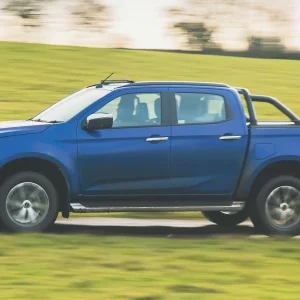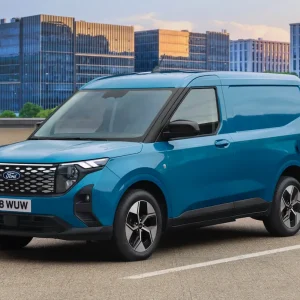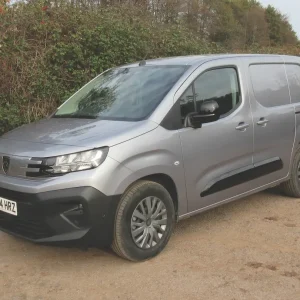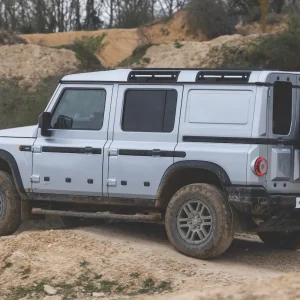A steady succession of mergers, takeovers and joint-ventures, implemented over the past few years with an eye to leveraging major cost savings, have made it increasingly difficult for motor industry brands to distinguish themselves from each other.
Citroën, Peugeot, Vauxhall and Fiat are now owned by global corporate giant Stellantis. As a consequence Citroën’s Relay, Peugeot’s Boxer, Vauxhall’s Movano and Fiat Professional’s Ducato are all fundamentally the same vehicle aside from the logos they bear.
So why buy one rather than the other for any reason other than the discount you are offered by the brand’s local dealer, the warranty provided or whether you think the dealer is any good or not? Fiat Professional has hit on a reason: the amount of technology that it has managed to cram into its vehicle.
As a consequence it is now claiming that the latest version of Ducato – its eighth incarnation – is the first ever light commercial to boast level two autonomy. While that certainly does not mean the Ducato can drive itself – a point we would like to stress strongly – the ADAS (advanced driver assistance systems) package it features means that driving it is both easier and safer than it would otherwise be.
As a consequence it won the What Van? Van of the Year for 2022, despite its otherwise-ageing design.
What Fiat has done is coordinate different functions on the Ducato so that they work together seamlessly.
Adaptive cruise control with stop and go ensures that the driver keeps a safe distance from the vehicle in front on the motorway, braking and accelerating, and stopping and pulling away again as and when required, without the individual behind the wheel having to do anything.
The package collaborates neatly with traffic jam assist. Its presence means that you no longer have to keep pressing the brake or accelerator pedal when you are inching along in a queue on the M6 for mile after wearisome mile.
At the same time lane keep assist gently steers you back into the lane you ought to be in if you lose concentration and your van starts to veer into the adjacent lane – and potentially into the path of oncoming traffic.
Once again we would like to stress that none of this means that the Ducato can drive itself. The driver still has to pay attention to what is happening on the highway ahead and all around the vehicle, and can intervene and override the technology at any point.
However, it is a harbinger of how light commercial automation is likely to develop over the next few years.
Aside from its considerably-enhanced on-board technology, the latest Ducato has undergone an external and internal makeover, with the cab receiving a new dashboard featuring a digital instrument panel, plus a different steering wheel and gear lever. The front of the vehicle has been restyled, with a switch to LED lights.
The newcomer gets the same 2.2L diesel as its Relay/Boxer/Movano stablemates at 120hp, 140hp, 160hp or 180hp. Married to a new six-speed manual transmission, the engine is 25% lighter than its predecessor, and is said to be 7% more frugal.
An optional nine-speed ZF automatic gearbox is up for grabs, and can be specified on everything, bar the least-powerful engine.
The battery-electric E-Ducato What Van? tested last autumn does not as yet share the updates enjoyed by its diesel-powered stablemate.
The Ducato comes with a load cube of from 8m3 to 17m3. It is produced as a van, a glazed van, a chassis cab and a chassis cowl and operators can choose from four different trim levels – Standard, Tecnico, Tecnico Plus and Business Edition.
Worthy of note is the arrival of Uconnect plus, the Fiat app that enables operators to enjoy a host of connected services.
MyRemote, for example, allows you to lock and unlock the doors even when you are quite some distance away from the vehicle, and to check its location. The Wi-Fi, with added Wi-Fi hotspot, enables the connection of up to eight devices and the use of Amazon’s Alexa,
We took off in a manual 140hp 3.5t LH2 Business Edition Ducato with a 13m3 load bay and a mountain of extra-cost options. Here is how we fared.

Load bay
A low loading height thanks to front wheel drive plus large door apertures ,make access to Ducato’s cargo area a doddle.
Our demonstrator came with a sliding nearside door plus twin back doors that could be swung through 90°, then through almost 270° if required; the latter facility is an option. Load area entry was particularly easy at the rear because the bumper incorporates a step.
We like the Ducato’s big, chunky door handles. Even if you are wearing thick working gloves, they are easy to use.
We played the game of count the load tie-down points. We found no less than 15 – eight on the cargo floor, two at the base of the full-height steel bulkhead, three at waist height on the offside and two at the same level on the nearside.
Tie-down points are of little use if you have no lashing straps. Accessible solely from the load area, the shelf above the cab looked like a good place to stow them.
The cargo bay was lined with ply; and that included the always-vulnerable wheel boxes.

Interior and equipment
No complaints about storage space in the three-seater cab, which was decorated with some fancy optional trim. Each of the doors has no less than four bins – two very small ones towards the top, a medium-sized one about halfway down with a moulding that can grasp a can of soft drink, and a big one at the bottom.
The lidded, but not lockable, glove-box has a shelf above it, with a lidded compartment above that set into the top of the dashboard.
Look towards the bottom of the dashboard and you will spy a tray with a couple of cupholders. You will also spot another cupholder next to a shelf as your eyes travel upwards.
Good to see that the fascia features a pair of 12V power points as well as two USB sockets. You can honestly never have enough of either; and our vehicle had an optional 240V power point as well.
Both the driver’s seat and the (slightly offset) steering wheel are height-adjustable and the seat boasts an armrest plus lumbar adjustment. The wheel features remote controls for the DAB radio.
Something we have never liked about the Ducato is the oddball positioning of the handbrake lever, between the driver’s seat and door. If you are wearing an anorak or a donkey jacket then you can pretty much guarantee you will get caught on it as you leave the driver’s seat, and you have to be extra careful the lever is fully released before you pull away from rest.
An electronic parking brake release is listed as an option.
When you are climbing back into the van you will notice an annoying omission; no grab handle on either of the A-pillars, or above either the driver or the passenger door.
The aforementioned projecting tray limits the legroom available to the middle passenger. On the positive side, however, the centre section of the middle seat’s back can be folded down and transformed into a handy desk complete with a couple of cupholders, a pen tray and a clip to keep paperwork tidy.
Standard kit includes automatic climate control, a wireless phone charger, electric windows and big, electrically adjustable and heated exterior mirrors with a separate wide-angle section. Opt for Business Edition trim and you get mirrors that fold electrically.
The dashboard is dominated by a large 10in touchscreen. Satellite navigation is included in the deal as well as Apple CarPlay, Android Auto, Bluetooth connectivity and wireless phone charging.
Voice response allows you to switch seamlessly away from BBC Radio 4’s increasingly annoying Today programme to Times Radio without even having to use the touchscreen.
Said touchscreen will ensure that your favourite radio stations and destinations are remembered anyway, and allows you to set the heating and ventilation system to your
ideal personal pitch of comfort. The touchscreen heating and ventilation controls are replicated with separate push buttons.
While the manual model does not achieve level two autonomy status in the way that its automatic stablemate does, our test van was by no means short of onboard safety features.
They included ABS, electronic stability control, emergency braking assistance and electronic brake force distribution. Our demonstrator was additionally equipped with an optional safety pack which embraces autonomous emergency brake control with pedestrian and cyclist detection, lane departure warning, traffic sign recognition and sensors that turn on the wipers when it is raining, the lights when it starts to get dark and dip the headlights as and when required.
Blind spot assist and rear cross path were installed as an optional pack. The latter alerts you to oncoming vehicles if you are reversing onto the highway.
While all this technology is undoubtedly laudable, sometimes it can be a bit overeager. No driver wants to be told by means of an onboard display – a 7in digital instrument cluster is fitted – to put his hands on the steering wheel when they are already there.
The driver’s airbag was supplemented by an optional double passenger airbag.
The traction control, lane departure warning and stop/start systems can all be switched off if necessary. Optional front fog lights with a cornering function were fitted and should help when visibility is poor.
The Ducato comes with electrically-assisted rack-and-pinion power steering with energy consumption and the level of assistance offered altering in line with the speed of the vehicle, says Fiat Professional.
Turning to the suspension, an independent MacPherson-type set-up helps support the front with wishbones, coil springs and an anti-roll bar. At the rear, you will find a rigid tubular axle with parabolic longitudinal leaf springs.
Telescopic shock absorbers are fitted all round.
Our demonstrator’s 16in wheels were shod with Continental VanContact Eco 215/75 R16C tyres.

Powertrain
Equipped with common rail direct injection, the Ducato’s electronically controlled four-cylinder in-line intercooled MultiJet III diesel features a variable-geometry turbocharger. Its maximum power bites at 3,500rpm, while top torque of 350Nm kicks in at 1,400rpm.
The AdBlue filler point is next to the passenger door beneath a flap that also conceals the diesel filler point.
Driving
For a big van, the LH2 Ducato is remarkably manoeuvrable at low speeds, and the rear-view camera delivers an exemplary daylight image on the aforementioned touchscreen when you need to back up. The screen also gives you the ability to switch the camera on to see what is behind you without having to engage reverse.
The image deteriorates markedly at night however, especially in wet weather. Such deterioration is not something unique to the Ducato, but is nevertheless something to bear in mind if you are making out-of-hours deliveries.
While the light power steering may be a boon around town, it fails to tighten up sufficiently at speed, despite Fiat Professional’s assurances to the contrary. As a consequence there were some occasions when we thought the handling lacked precision, with the van feeling a little nervous and uncertain as we started to swing into bends.
Nor was the ride always all that smooth. It tends to be choppy when the Ducato is lightly laden, although it undoubtedly starts to improve when you put some weight in the back; a characteristic the van shares with most light commercials of its size.
In-cab noise levels could stand to be better suppressed, and the quality of the manual gear change is acceptable rather than outstanding.
With 140hp on tap there is no shortage of performance. Although we might be tempted to step up to 160hp or even 180hp if we were tackling a lot of intercity runs heavy laden. Pressing the ECO button should improve your fuel economy, and does not affect your vehicle’s performance unduly unless you happen to have a lot of weight on board, or have decided to pull a heavy trailer.

Operating
Ducato’s warranty lasts for five years/125,000 miles under the 555 banner, with roadside assistance provided for the duration as part of an impressively comprehensive package that also includes regular servicing for the first 100,000 miles. Service intervals are set at two years/36,000 miles.
Our test vehicle was finished in optional Lanzarote Grey paint which also graced the front bumper. Looks nice, and so it should for an extra £1,100 in total – but just remember that it will not earn your business any more money, any more than the fancy optional crepe black interior cab trim or the optionally leather-trimmed gearlever and steering wheel will.
Side rubbing strips protect the Ducato’s body from minor damage and the van we tested came with a full-size spare wheel.
We averaged 35mpg – slightly better than the official figure.
Fiat Professional Ducato 35 LH2 2.2 MultiJet III 140hp Business Edition
Price (ex VAT) £37,950
Price range (ex VAT) £30,755–£46,900
Gross payload 1,472kg
Load length 3,705mm
Load width (min/max) 1,422mm/1,870mm
Load bay height 1,932mm
Load volume 13m3
Loading height 590mm
Rear door aperture 1,562mm x 1,790mm
Side door aperture 1,250mm x 1,755mm
Gross vehicle weight 3,500kg
Braked trailer towing weight 2,250kg
Cost per mile 78.8p
Engine size/power 2,184cc/140hp @ 3,500rpm
Torque 350Nm @ 1,400rpm
Gearbox 6sp
Fuel economy 34mpg (combined WLTP)
Fuel tank 90L
CO2 216g/km (WLTP)
Warranty 5yrs/125,000mls
Service intervals 2yrs/36,000mls
Insurance group 43A
Price as tested £42,905
* after 48 months/20,000mls p.a – source – KWIKcarcost
Options
External pedestrian alarm £35
Safety pack £595
Leather-trimmed steering wheel and gear lever £170
Lanzarote Grey paint £600
Painted front bumper £500
Double passenger airbag £255
Crepe black interior £150
Digital central rear view mirror £595
230V socket £150
LED daytime running lights £280
Front fog-lights with cornering function £150
Black front grille and chromed bars £120
16in black alloy wheels £560
Blind spot assist and rear cross path £495
270° rear doors £300
Rivals
Ford Transit
Price (ex VAT) £32,985–£54,135
Load volume 9.5–15.1m3
Gross payload 895–2,209kg
Engines 105hp, 130hp, 170hp, 185hp 2.0 diesel, 135kW, 198kW electric motor
Verdict: Ticks almost all the boxes. Plus points include a slick manual gear change, an exemplary 10spd automatic transmission, a wide range and strong aftersales support. The E-Transit looks like the model to watch from now on, with a competitive price tag and a claimed maximum range between recharges of just shy of 200 miles on the WLTP cycle.
Mercedes-Benz Sprinter
Price (ex VAT) £29,435–£58,575
Load volume 7.8–17m3
Gross payload 731–2,813kg
Engines 150hp, 170hp, 190hp 2.0 diesel, 85kW electric motor
Verdict: A heavy stress on on-board safety characterises the Sprinter, a durable fleet workhorse, which should offer healthy residuals, and is wired for connectivity. Front-wheel and rear-wheel drive variants are both available. Check out the automatic models and do
not neglect the electric version, although, admittedly, its range is woefully short.
Volkswagen Crafter
Price (ex VAT) £29,280–£46,905
Load volume 9.3–18.4m3
Gross payload 761–2,472kg
Engines 102hp, 122hp, 140hp, 177hp 2.0 diesel
Verdict: Crafter and its MAN TGE identikit stablemate tend to be overshadowed by the all-conquering Mercedes Sprinter. That is a pity, because they share the Sprinter’s emphasis on safety and durability. Like the Sprinter, they are supported by dedicated commercial vehicle networks; and MAN has managed to launch an electric TGE in the UK.
The Final Verdict
Design 8/10 – Using refined onboard technology to gain an edge is a praiseworthy ploy
Cabin 8/10 – Well-equipped and comfortable, with plenty of gizmos and lots of storage space
Ride 6/10 – Not its strong suit, especially when lightly-laden
Refinement 7/10 – In-cab noise needs to be suppressed, but much better built than its predecessors
Load area 8/10 – Roomy and easy to access with plenty of tie-down points
Handling/performance 7/10 – Over-assisted steering harms the former but performance is sufficient
Engine/transmission 7/10 – Well-matched, but the manual is not great. Splash out on an automatic instead
Standard equipment 7/10 – A worthy selection of goodies, but gaps require a check of the options list
Operating costs 9/10 – A remarkably comprehensive package should help keep them nicely under control
What Van? subjective rating 7/10 – A cleverly thought-out vehicle, but the automatic is much more preferential
Overall Rating = 74/100





